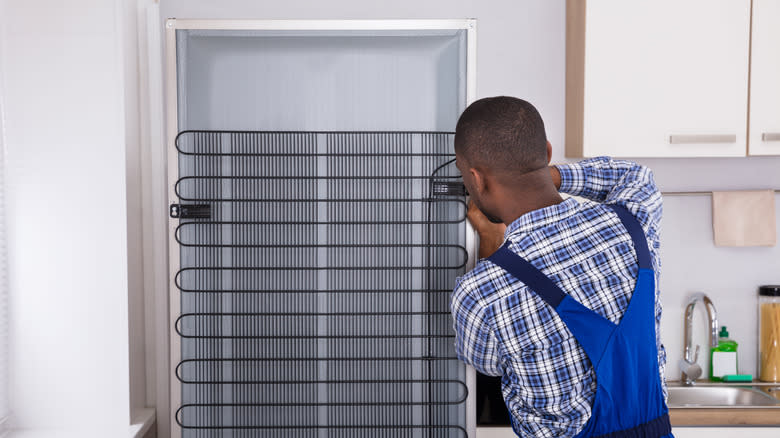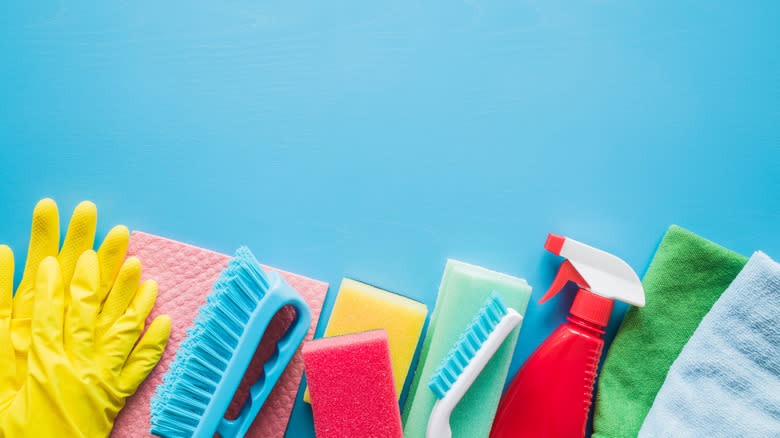You're Probably Forgetting To Clean Your Refrigerator Coils

Kitchen surfaces generally get cleaned quite often over the course of a day or a week. As a family goes about their day, dishes are washed, counters are wiped, and spills are dealt with — but hidden crevices and corners are often forgotten, or left with promises to deal with it another day. One such neglected part of the kitchen is the back of the refrigerator, that mysterious dark place that few dare to venture into.
The structure of the fridge is such that it must be set away from the wall so the condenser coils have room to operate effectively. Unfortunately, this means that it's extremely easy for dust to get trapped among the coils in the space between the fridge and the wall. The awkward positioning makes it difficult to clean regularly.
However, there is good news. While it may be cumbersome, actually cleaning the back of the fridge is not too complicated a task. Just get the appropriate cleaning materials together, unplug the fridge, and get some help to move it away from the wall so you can better reach the back. Once the fridge coils, kitchen floors, and surrounding walls have been cleaned, move the fridge back into position, plug it back in, and you will be rewarded with a more efficient fridge.
Read more: The Best Way To Clean That Nasty Grease Off Of Your Kitchen Cabinets
How To Clean Refrigerator Coils

The main tool you'll need is a long, flexible brush, like a large pipe cleaner or bottle brush. Other items you need are a damp rag or sponge, plus a microfiber cloth. Remember also to wear a face mask to protect yourself from inhaling dust.
Once the fridge has been safely unplugged and moved away from the wall, let it rest for at least ten minutes. In case the condenser coils are running hot, this will give them time to cool slightly so you don't accidentally injure yourself. Then remove as much of the dust trapped between the coils as possible with the flexible brush. Once all the dust has been cleaned away, wipe the condenser fan blades with a damp rag or sponge. Use the microfiber cloth to wipe it all dry. Avoid using liquid cleaners for this task, as they may corrode the metal over time.
But don't stop there. Since the fridge is already away from the wall, take the opportunity to dust and wipe the now-exposed floors and walls. Make sure all the surfaces are dry before moving the fridge back into position, then plug it back in to power it up again.
Why Cleaning Refrigerator Coils Is Important

The coils are part of the refrigerator's compressor, which circulates the coolant that regulates the temperature of the appliance (also called the "refrigerant"). This cooling process gives off heat via the condenser coils. When these coils are unable to disperse heat effectively, the compressor uses more energy to ensure that the fridge continues to be cool. All of this contributes to more energy usage, which in turn increases your electricity bill.
If the fridge cannot maintain a cool temperature, the food stored inside will spoil at a much faster rate, leading to food poisoning and food wastage. Aim to clean the coils and fan about twice a year for maximum efficiency and prolong the life of your fridge.
When you carry out a deep clean behind your fridge, consider cleaning the inside of the fridge and freezer as well. Time these cleaning sessions for when you are running low on perishables, or ask a neighbor if you can park some items in their fridge for half a day. While the refrigerator is unplugged, you can completely empty the fridge and freezer compartments. Remove the shelves and any other detachable components, then give everything a good scrub and wipe.
Read the original article on Daily Meal.

 Yahoo Finance
Yahoo Finance 